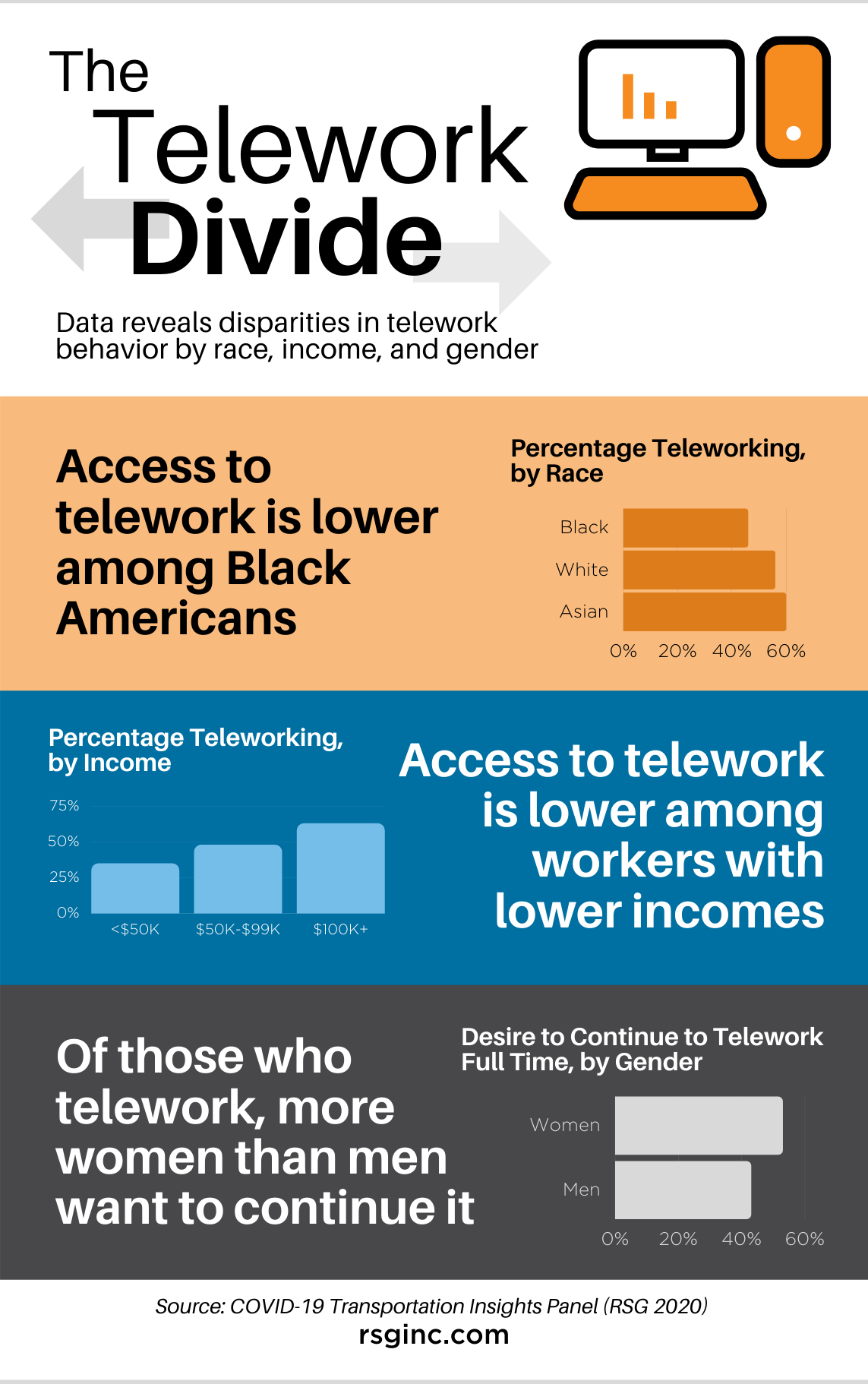Telework has gone mainstream in 2020. Many companies, including some big names in tech, have decided to keep employees remote well into 2021 due to concerns over COVID-19. Commercial spaces in major cities remain largely vacant as employers adopt a wait-and-see approach to recalling workers to offices.
These telework changes are having an immediate effect on travel. Longer term, it remains to be seen which, if any, of these behaviors will persist. Too many unknowns complicate the picture. However, if just a small percentage of workers who began working remotely this year continue to do so, the effects on everything from land use to toll roads and congestion pricing could be profound.
But who is teleworking now, and what does the current picture tell us about the future of travel?
To answer these questions, we analyzed data collected from two waves of responses between May and July as part of our COVID-19 Transportation Insights Panel. Specifically, we looked at COVID-19 impacts on work-related travel across 6,143 adult respondents. Here’s what we found, why it matters, and what we’re looking for in future waves.

What we found among our respondents
Our survey found that only 46% of Black workers are currently teleworking, compared to 56% of White workers and 60% of Asian workers. These results align with previous findings from the US Bureau of Labor Statistics, which found lower access to telework among Hispanic, Latino, and Black wage and salary workers.
We also found a significant disparity in telework across income groups regardless of race. For instance, as of July 2020, only 35% of workers in households with incomes under $50,000 were teleworking, compared to 48% of workers in households with incomes of $50,000–$99,999 and 63% of workers in households with incomes of $100,000 or more.
Among respondents still commuting to work, we found that 95% of those in households with incomes of $50,000–$99,999, and 92% of those in households with incomes of $100,000 or more, typically commuted to work using a household vehicle rather than transit or other shared modes. Among households with incomes under $50,000, only 81% do the same.
Across all racial and income categories, 53% of women currently working from home some or all of the time would prefer to work from home five or more days per week in the future, which is 10 percentage points higher than men. Conversely, 12% of men would prefer to work from home less than weekly or never, whereas the same is true for only 5% of women.
Why these findings matter to transportation planning
The sudden shift to telework in March 2020 meant that millions of Americans stopped commuting and started working from home. However, not everyone holds a job that can be performed remotely. Jobs that do allow for telework are more likely to be held by workers who are White and higher income.
The ability to telework and access to transportation options are known determinants of health outcomes. Specifically, having a personal vehicle, which our survey found is more often the case among households with higher incomes, allows individuals to socially distance more easily than would be the case while using transit or other shared modes. This also suggests that households with lower incomes are more likely to be affected by current reductions in transit service or capacity.
Many minority and lower-wage workers have been disproportionally impacted by COVID-19, resulting in an inequitable and well-documented split in travel and work patterns across demographic groups and by income. Our first and second wave survey findings contribute to the growing body of evidence showing that racial minorities and lower-income households are being left behind when it comes to teleworking and commute options that allow for social distancing (e.g., a personal vehicle).
What we’re looking for in future waves
Results from our next wave will provide additional evidence of the staying power of the trends we have observed in the first two waves, particularly around telework. Given growing attention to racial, socioeconomic, and gender disparities evident in the shift to remote work, we will examine whether the inequities we have observed to date decrease, stay the same, or increase among our respondents. Respondents’ expectations and plans around teleworking, including their employers’ willingness to allow them to do so, will be particularly insightful from a transportation planning perspective.
We will also look to see how teleworking has changed respondents’ other trip-making behaviors. For instance, previous research has pointed to negligible environmental benefits associated with telework due to the lack of chained trips in which workers commute to work and return home, completing errands along the way; some remote workers actually end up driving more as a result of teleworking.
We may also look to see whether respondents who telework have moved and relocated, since there is some anecdotal evidence that many people who live in cities may choose to relocate to cheaper areas with lower population densities. However, such a move would also have the effect of increasing personal vehicle miles traveled, which would require further research. A competing hypothesis that young workers may move into city centers as businesses move out may also come to fruition as telework increases.
······························

Check out our COVID-19 Transportation Insights Panel page for a brief overview and FAQ. You can also contact us to receive a customized survey demonstration to see how TIP can help your agency adapt to the present and plan for the future.


